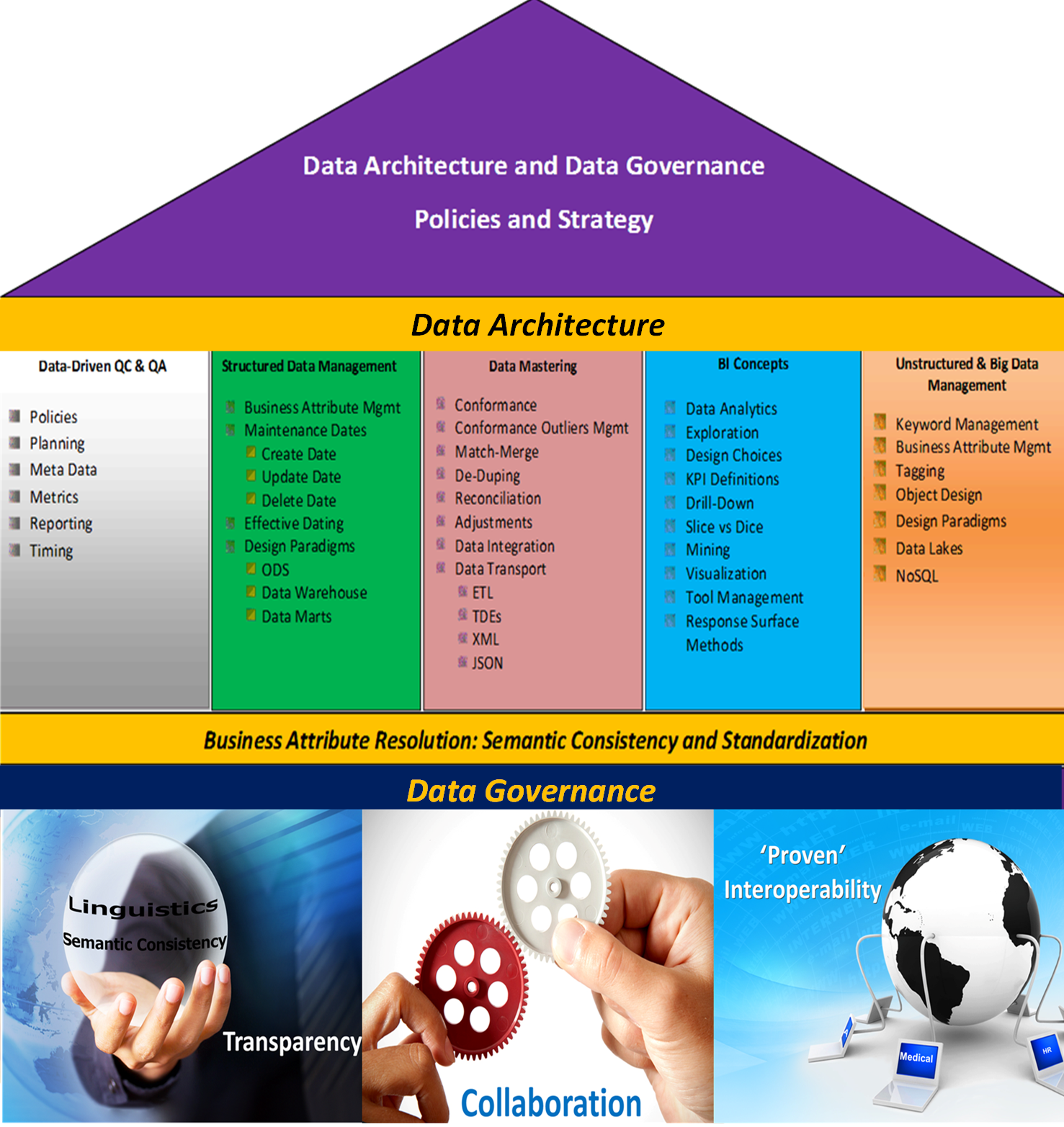Data Architecture and Data Governance

The GITS Data Management Big Picture
A comprehensive Data Architectural program may potentially have a lot of moving parts. It is important to understand the overall landscape in order to determine what would need to be addressed when. GITS provides an ‘ala carte’ method of developing Roadmaps and Frameworks within the context of implementing Data Architectural Framework and Data Governance Components.
DATA ARCHITECTURE AND DATA GOVERNANCE POLICIES AND STRATEGY
 When Business Requirements and Corporate Policy Documents are written, it is important to demonstrate, when possible, that Business and Technical Resources are keeping an accurate record of what was done and why. It is their joint responsibility to track how these Policies and Charters are being realized within the context of the GITS Data Management Complex. GITS will analyze your Policies and Strategies and identify which Policy documents can be improved, and demonstrate how to incorporate your Policies and Strategies into your Value Chain.
When Business Requirements and Corporate Policy Documents are written, it is important to demonstrate, when possible, that Business and Technical Resources are keeping an accurate record of what was done and why. It is their joint responsibility to track how these Policies and Charters are being realized within the context of the GITS Data Management Complex. GITS will analyze your Policies and Strategies and identify which Policy documents can be improved, and demonstrate how to incorporate your Policies and Strategies into your Value Chain.
Data-Driven QC and QA

Have you considered the fact that a robust Data Quality Management program will minimize the need to perform Patient Matching? If your vendors have not told you that, then have you asked – why not? Did you know that all data attributes are not created equal, and therefore may have different data quality requirements? Are you familiar with the affect that data provenance has on defining data quality requirements? GITS has routinely introduced our Data quality management program is a number of industry segments, with consistent results. We simplify data quality management and our APIs are data-driven, minimizing the need for programming.
STRUCTURED DATA MANAGEMENT

GITS will provide ‘Best Practices’ Data Architectural methods for managing Structured Data. Our resources will provide guidance and knowledge transfer on effective Data Acquisition techniques, Data Model Standardization, Process Modeling methods, Meta-Data Management, and on developing a Technical Architecture Design to accommodate your Structured Data needs.
Data Mastering

Master Data Management (MDM) has become a hot topic among Data Architects lately. The concept is predicated on the idea of creating a error-free set of data items for which there are existing Data Quality problems – hence, the resulting collection data items will comprise a ‘perfect’ record of information for a given business subject (e.g., Product, Customer). These perfect records of information are often referred to as ‘Master Records’. The GITS Methodology includes the concept of ‘Master Data Management’, but we also include all activities that are needed to truly ‘Master’ your information. Examples are below:
-
- Optimizing your Value Chain to realize benefits from ‘mastering your Data’
- Match-Merge Methods
- Conformance Methods for Incoming Data
- Management and Reporting of Data that cannot be conformed (i.e., ‘Outliers’)
- Prepackaged Data Objects (e.g., Decision Support, BI)
- Visualization Methods
- De-Duping (i.e., How to manage duplicate data)
- Reconciliation (i.e., How to deal with information that has already been consumed)
- Making Adjustments to Data Post-Mortem (after the information has been published)
- Data Integration Methods and Paradigms
Business Intelligence (BI) Concepts
![]()
Business Intelligence can aid in addressing Regulations, improving Patient Outcomes and streamlining Supply Chain management. GITS will provide methods and procedures that are aligned with best practices for determining the best Design Paradigm (i.e., Operational Data Stores (ODS), Data Warehousing, Data Vaults, Canonical Model-Based Storage Structures, etc.) that is germane to Business Intelligence. The methods and procedures that are provided will facilitate decision-making based on usage patterns. These Design Paradigms will allow decision-makers to view necessary information on Dashboards by pre-packaging data structures that will allow the end-users to visualize Data Analytics and selected Metrics.